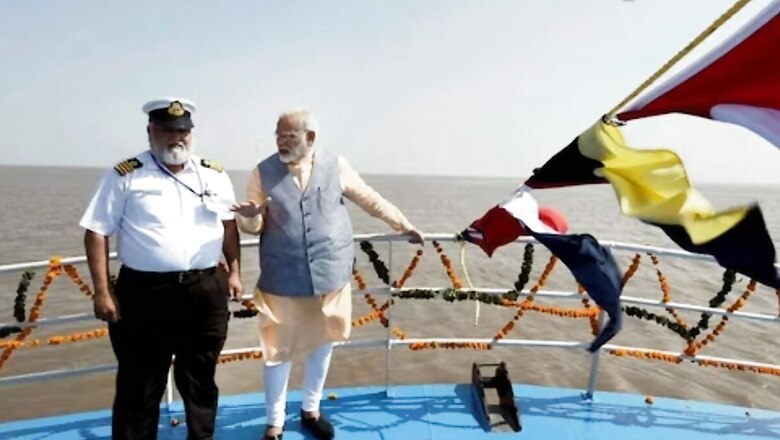
views
India has once again secured its re-election to the International Maritime Organization (IMO) Council with the highest tally of votes.
This places India in the category of 10 states that have “the largest interest in international seaborne trade”, alongside Australia, Brazil, Canada, France, Germany, the Netherlands, Spain, Sweden, and the United Arab Emirates (UAE).
India received significant backing from the international community at the International Maritime Organisation (IMO), ensuring its continued service in the global maritime domain. The IMO, as the principal authority overseeing the maritime industry, plays a crucial role in regulating global trade, transportation, and all marine operations. The verdict underscores India’s resurgence as a prominent maritime player in the world.
Union Minister for Ports, Shipping and Waterways Sarbananda Sonowal said, “The Ministry has made every possible effort under the leadership of PM Modi. We are delighted and humbled by the support of the international community at the International Maritime Organisation for India. The highest votes are indicative of the government’s determination to strengthen India’s varied contributions to international maritime operations.”
As the Indian Ocean’s importance rises in global trade and geopolitics, India seeks to play a bigger role in the high seas. It aims to expand its international role, whether in the realms of trade and shipping or in upholding international maritime law and ensuring freedom of navigation.
AMRIT KAAL VISION FOR INDIAN MARITIME PROWESS
Enhancing India’s maritime presence is a goal defined in the government’s Amrit Kaal Vision 2047.
The action plan encompasses 43 initiatives, with a primary emphasis on enhancing our worldwide maritime influence.
Key measures include establishing a specialized IMO cell in India, designating a permanent representative at the IMO headquarters in London, executing the BIMSTEC Master Plan, and establishing a resilient institutional framework for BIMSTEC to facilitate the coordinated and timely implementation of regional projects.
India’s continued representation in the IMO is important as it works on expanding its maritime presence with a larger stake in world shipping.
Under Prime Minister Narendra Modi’s Maritime Amrit Kaal Vision, an increasing emphasis is being placed on increasing India’s maritime footprint with more Indian flag ships as compared to foreign flag ships to ensure greater Indian tonnage, especially along coastal shipping routes.
“The growth of Indian flag shipping tonnage has not kept pace with the growth of Indian trade needs,” the document acknowledged.
Over 93% of Indian international cargo, and approximately 39% of total Indian cargo (including coasting and offshore fields), is transported by foreign-flagged ships, resulting in an annual freight expenditure of around $75 billion. The participation of Indian tonnage in global cross trades is minimal, with negligible freight and receivables.
There is a pressing need for a focused and dedicated shipping policy to enhance the competitiveness of Indian shipping against foreign counterparts operating on the Indian coast, ensuring a level playing field in international trades.
With this in mind, the document presents a slew of proposals to provide a level playing field and make Indian flag shipping competitive against foreign flag ships. It aims to boost trade of “make in India” goods and will also help save billions of dollars in annual freight bill paid to foreign fleets.
INDIA’S STRATEGIC ADVANTAGE IN MARITIME TRADE
India possesses a coastline exceeding 7,516.6 km, featuring over 200 ports. The majority of cargo vessels navigating between East Asia and America, Europe, and Africa traverse Indian territorial waters, granting India a notable competitive edge.
With 50% of the world’s trade flowing through the Indian Ocean, India holds a strategically advantageous position in maritime trade.
India has already achieved its $720 billion target for FY2023 for exports from ports.
Trade will improve further with IMEC and other projects coming through. The country is a part of the India-Middle East Europe Economic (IMEC) which will run from India to Europe via UAE, Saudi Arabia, Jordan and Israel. It’s also developing the Chennai-Vladivostok Eastern Maritime Corridor and the Northern Sea Route with Russia.
ENHANCING PORT CAPACITY
India is developing new ports and building greater port capacity. The Vizhinjam port in Kerala is the first deep sea port in India and will attract the world’s largest ships to dock in its waters.
The government has cleared the development of a major port in Vadhavan, Maharashtra at an estimated budget of ₹71,000 crore.
Another major container transshipment terminal is being planned for the Galathea Bay in the Great Nicobar lsland of Andaman & Nicobar lslands. This project’s estimated budget is ₹48,000 crore. Both projects will be steered under the public-private partnership model.
Over the period from 2014 to the present, the capacities of the 12 major ports have more than doubled, reaching nearly 1,600 million metric tons.
Each of these ports is undergoing development to become a mega port, attracting global investor attention and positioning them to compete on a global scale.
During the fiscal year 2023, India efficiently handled around 790 million metric tons of cargo, achieving the highest record and experiencing a 10 percent increase compared to the previous year, across its major ports.
India is actively pursuing various initiatives to enhance its port ranking, focusing on an ‘ease of doing business’ approach.
Measures such as direct port delivery, entry facilitation, container scanner installation, and RFID-based gate automation aim to minimize cargo waiting times. Improvements in loading, unloading, and berthing processes are also underway.
Over the past eight years, India has risen 16 positions in the World Bank Logistics Performance Index, reaching 38 out of 139 surveyed countries. In international shipments, India advanced from 44th place in 2018 to 22nd.
Notably, India boasts a three-day average container dwell time, surpassing durations in the UAE, South Africa, the US, and Germany. The turnaround time at ports like JNPA is an impressive 0.9 days (22 hours), outperforming even advanced nations such as the US, Germany, Canada, and Australia.
With a burgeoning blue economy, India’s prominence in maritime affairs is slated to grow further.
At this pivotal juncture, the Modi government seeks to contribute maximally to global regulatory aspects through authorities like the IMO. This is in coherence with its plans to enhance port capacity and shipping tonnage with a greater share for Indian companies as against foreign ships.

















Comments
0 comment